The Sensual & The Intellectual: The Art of Anthony Sonnenberg
29.03.16
A long time ago, in a small Texas town, the son of a dentist and a gardener was raised. He spent his days building small sculptures out of wax in his father’s dental practice, or helping his mother make the family flowers bloom.
It isn’t always obvious how childhood will follow us into art. But for artist Anthony Sonnenberg, those two influences hold strong.
Sonnenberg’s sculptures are a play of porcelain and flowers. Some sculptures look like pristine metallic lava flowing over a complicated yard sale. Others draw on delicate gold flowers, while still others explore the human body and consumption.
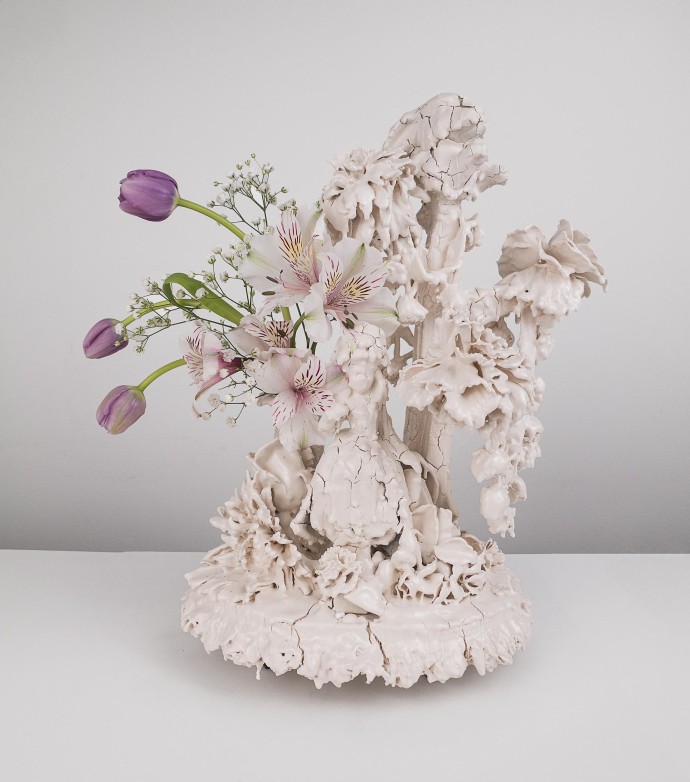
“Vignette #1 (for Ann Agee),” Porcelain over stoneware, found ceramic tchotchkes, glaze, fresh flowers, 2016.
The amorphous but familiar shapes of his sculptures keep the eye. His work is a visual puzzle of darkness and complexity.
I spoke with Sonnenberg about his approach to art and aesthetic from his studio as he prepares for his next show, which opens on April 8 at the Art Palace in Houston, Texas.
SARAH ROSE ETTER: First, I’m obsessed with your work. Second, how did you get into all of this?
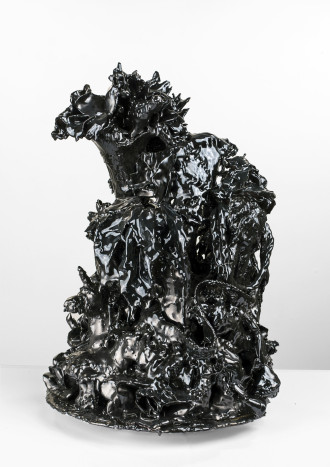
“Black Beauty,” Porcelain over stoneware, found ceramic tchotchkes, glaze. 2014.
ANTHONY SONNENBERG: I was always a person who made things. My dad made dentures in this small office. I would sit back there and make things with that wax. I’d make hot air balloons and frogs and flowers. That was my earliest kind of workshop.
I grew up in a really small Texas town, so there wasn’t much art education there. I took pastel classes with ladies who had back rooms. We’d pick pictures out of National Geographic Magazine and do them in pastel. That was my other workshop.
Then I went to art school, and I was no longer the only one who was interested in art. Suddenly, I was surrounded by people who knew so much. Suddenly, I had access – which is a challenge with sculpture – to a kiln. As soon as that happened, it hit me that this is what art is.
SRE: Your work is complicated, especially when it comes to the decadence of the layers of your pieces. Many of your pieces seem to almost obscure themselves – particularly the ceramics. There’s a lot of hunting and discovering for the eye to do. Can you talk a little bit about how you arrived to this process?
AS: I’ve always been very interested in the Old Masters. Baroque, Bernini – those are my measuring sticks for my work. The old masters are impossible to catch up to, but that’s where I get the glitz and the glam.
The work of the old masters always puts the sensual before the intellectual. It’s so direct. It’s just undeniable and universal in its appeal.
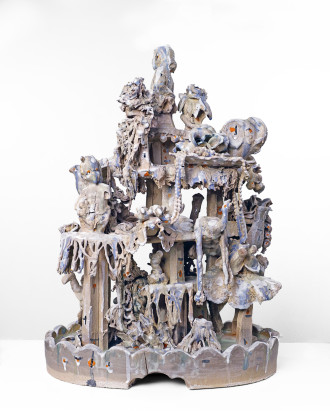
“Big Candy,” Stoneware, found ceramic tchotchkes, silk flowers and dollies, glaze, silica sand, enamel, platinum luster. 2014.
It’s pure propaganda, too. It’s just the church pouring money into these artists to get people on their side. And the artists, for their part, aren’t afraid to pull out all of the stops. They’re at a visual kind of war.
The flowers and the feminine has always been part of my work. I’m a gay man, but rather than putting graphic sex forward, it’s the flowers.
Growing up in a small Texas town for me lent itself to a kind of duality. Everyone in town has two parts – you know their public face, and then the gossip about them.
There’s a subtext about everyone, and then there’s the actual conversation you have. “My daughter is doing wonderfully!” someone’s mother might say, but everyone knows the daughter is in community college and pregnant. There are always these two layers – so I think that’s kind of the balance for mine. Sexuality and dark tones are in the work, but I don’t want them to be on the surface. They are always shimmering underneath. It’s much more potent this way.
SRE: While you’ve gone through a few different materials – taxidermy, gold, and porcelain – your work always seems to stay within your own aesthetic. It always feels very you. What drives that?
AS: Well, I build a framework. I select the aesthetic and vocabulary that I want the pieces to operate in. I build up ideas and images, and then determine which ones are worth the investment. I certainly invest in ideas that fall apart, don’t get me wrong. But it’s a lot of work to let go, so I try to be smart about it. You can’t give away too much or go too far.
But I mine images of art history and find what sticks with me. Vases from cemetaries or Ming vases, chandeliers or old screens for instance. I take those pieces on as a challenge, or find narratives in them and attach myself to those. That’s the overall approach.
Porcelain has a specific luxuriousness to it. It’s also got a certain expense associated with it, but it’s not like bronze or gold. It’s not a high-high material. So it’s a real sweet spot where you can talk about luxury and expense, but there’s room to move around with it since it’s not so loaded and hierarchical.
Most of the ceramic sculptures are made using textiles and silk flowers. I dip those materials, and then the kiln incinerates everything. I also use porcelain objects so that I’m getting things that have history and identity.
I’m more of a bricolage artist, really. I stick things together. I learned early on that I’m not a factory. I can’t make the specific detail that I want by hand, so I had to find another way to do it.
It really came down to: this I what I want to make but how do I make it? Then getting into it, I loved the history coming through it. Hunting for the objects, I never know what I’m going to find. I can almost never find two of the same thing when I’m hunting, so that throws symmetry out the window.
As long as I take my time and dry thoroughly and kiln slowly, things won’t blow up. And trust me, things have blown up before.
SRE: Who inspires you?
AS: Always the Old Masters. They are in a way, the base from where I start. I think it’s important to look at older art. I’ve been watching a series of Charles Ray conversations, and he talks about how it’s no mistake that certain objects can still speak to us even though they are thousands of years old. There are so many things that are made that get thrown away and they don’t speak to us or have meaning anymore. So if a piece of art lasts 500 years or 600 years, they must have done something right.
I also look to Jeffrey Mitchell in Seattle. He is my mentor in many ways. He reminds me there are certain insecurities you will never get over. Plus, we have a similar aesthetic – so I’m always inspired by him. Anne Agee is another ceramic artist who is really great.
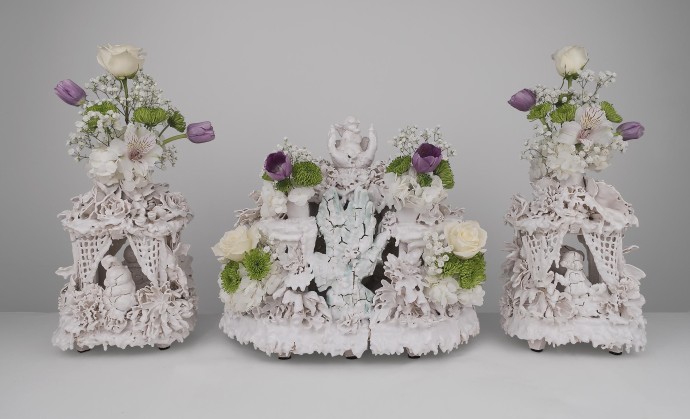
“Epergne Set,” Porcelain over stoneware, found ceramic tchotchkes, glaze, fresh flowers, 2016.
SRE: Can you talk a little bit more about what’s influencing your current work? Your latest Facebook post included a sneak peek of some intriguing new pieces.
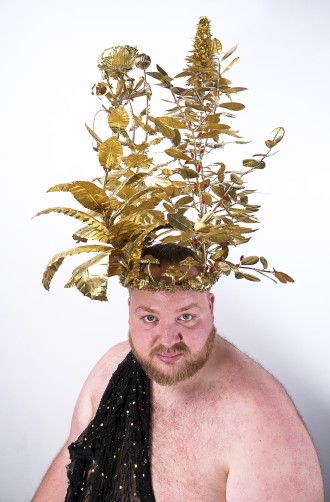
“Crown for Silenus,” Hand cut and shaped brass sheeting, brass piping, red coral, silver solder. 2014.
AS: Right now, I’m really interested in the narrative of Silenus. I saw this Van Dyck painting of Silenus. Silenus is this drunk who raised Dionysus. King Midas eventually kidnaps him. King Midas demands that Silenus tell him the most valuable thing. This leads Silenus to break down – he says “Why are you asking me things that a mortal should never know?”
It’s this big moment, this Greek dramatic understanding that being alive is suffering. I’m really interested in Silenus right now, in these esoteric questions about mortality, about being alive and drunk.
I’m a bigger person, and the idea of consumption is important to me. It’s a personal truth that I know, and from there I can launch out into the art. In some of the beaded self-portraits, you can see that at play.
I think about this a lot actually. These themes are pervasive in the work. I’m beholden to these things – sensuality and art history. Emotionally and sensually, we’re all so similar. We all want love and we’re all thinking about dying. So what are the things that are most universal to people and how can I harness it? It’s all a conduit to something deeper.
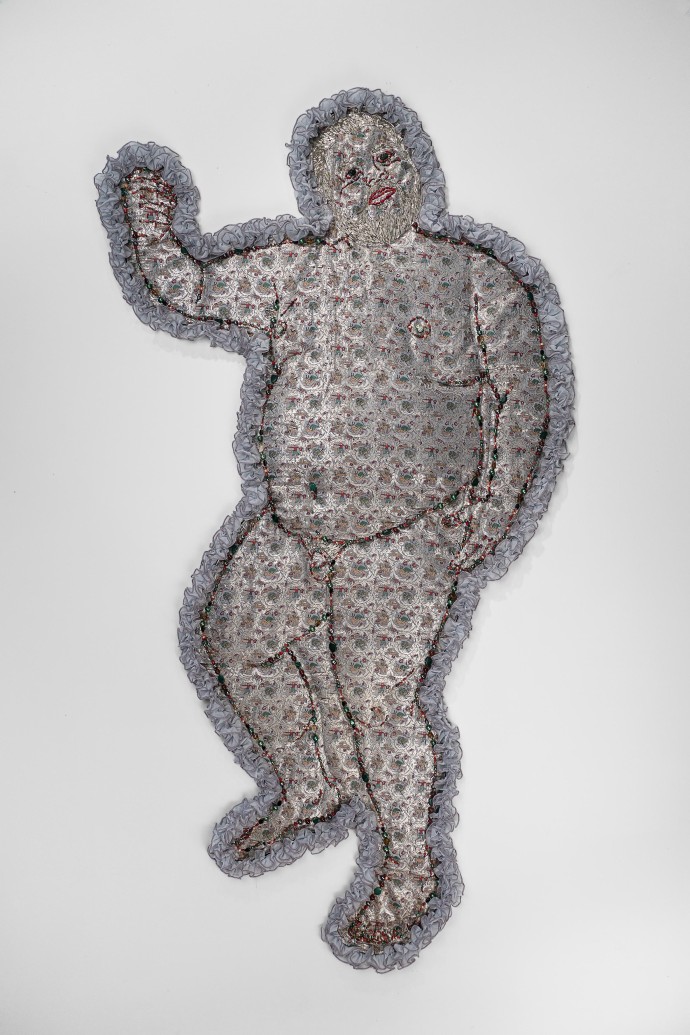
“Dionysus (Self-Portrait Pillow),” Found fabric, semi-precious stones, crystal beads, fringe, batting, 2015.